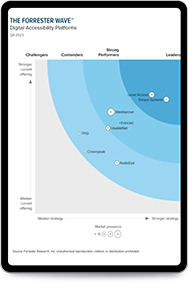Three Reasons Why B2B Companies Must Prioritize Digital Accessibility
Jan 15, 2024
This blog was contributed by Level Access’s Chief Accessibility Officer Jon Avila.
Not too long ago, I was on a call with a colleague at a software company, when they said something that troubled me. They mentioned that digital accessibility was not a concern for their organization, since their product is sold to other businesses, not directly to consumers. I understand where they may have gotten this impression. Many of the headlines about digital accessibility revolve around web accessibility lawsuits targeting large retailers, banks, and consumer brands. But the idea that business-to-business (B2B) organizations shouldn’t bother with accessibility standards couldn’t be further from the truth.

Accessibility isn’t just relevant in the business-to-business (B2B) space—it’s a game-changer. In fact, our recent State of Digital Accessibility survey found that 85% of respondents at B2B organizations consider digital accessibility a competitive advantage, and 64% say digital accessibility has contributed to revenue growth. But, as my recent conversation revealed, some organizations still don’t grasp the importance of B2B digital accessibility. And by the time they do, they’re already at risk of losing business.
In this piece, I’ll explore three reasons why B2B companies must embrace digital accessibility to succeed in today’s market.
Accessibility is quickly becoming a standard requirement in B2B sales
The data is clear: today’s buyers are prioritizing accessible products. Nearly three in four senior leaders we surveyed (73%) say that digital accessibility is a requirement for software procurement at least most of the time. If vendors can’t keep up with these requirements, contracts are at risk.
There are good reasons for this trend. First, as part of a holistic approach to digital accessibility, purchasing accessible third-party software enables consumer-facing organizations to serve more customers, and to provide consistent experiences to all users. Second, many consumer-facing companies have a legal imperative to ensure digital technology is compliant with the Americans with Disabilities Act (ADA) and other global accessibility laws. And that includes technology from third-party vendors.
If a bank integrates inaccessible third-party software for its customers to use to complete payments or request statements, it could face a lawsuit. Similarly, a retailer that uses a third-party integration to personalize search results on its e-commerce site may be held legally accountable if this integration creates accessibility barriers for users.
With upcoming European Union (EU) legislation, I anticipate that B2B digital accessibility will play an even more critical role in procurement for companies that currently operate in, or plan to break into, the European market. The European Accessibility Act (EAA) mandates that a variety of products and services—including many types of digital technology—that are sold in, or imported into, Europe meet accessibility standards. That means the providers of certain types of covered products and services will need to prioritize accessibility to legally do business in Europe, regardless of whether these products and services are purchased by organizations or consumers.
In fact, I know of many B2B organizations that are already taking action to meet EAA requirements. Companies that sell point-of-sale devices are preparing to make sure these devices are accessible, as businesses are prioritizing EAA-compliant models in their buying decisions. Similarly, numerous computer and mobile phone manufacturers have started the process of bringing these products into conformance with accessibility standards so that they can be imported into the EU for sale.
Digital products that work for everyone increase client retention
Over the course of my career as an executive at a B2B company, I’ve learned that good business isn’t just about driving sales—it’s about helping clients solve problems for their customers. This is especially true in the current economic climate, as both B2C and B2B companies increasingly recognize that retention is key to sustainable growth.
By integrating accessible products, consumer-facing companies can solve problems for more customers. And by providing accessible solutions, B2B companies keep their clients happy. In our survey, 78% of professionals from B2B organizations say digital accessibility has contributed to improved client satisfaction, and 69% say it has contributed to improved client retention. This makes intuitive sense. When a consumer-facing company receives a flurry of customer complaints—or an ADA demand letter—because they’ve integrated inaccessible third-party software, they’re not likely to renew their contract.
Beyond compliance, many companies prioritize digital accessibility as part of their commitments to diversity, equity, and inclusion (DEI). In fact, 38% of respondents to our survey count fulfilling DEI commitments among the factors that continue to drive their digital accessibility programs. When evaluating existing relationships with vendors (as well as when procuring new tools), organizations may factor in whether these vendors are bringing them closer to, or further away from, their DEI goals.
Notably, companies committed to DEI may aim to provide equitable digital experiences not only for clients, but also for their own employees. That means ensuring that employee-facing software, like intranet systems, from third parties is accessible—not just customer-facing software. As organizations double down on internal commitments to DEI, they’re likely to maintain relationships with vendors who provide accessible products and discontinue relationships with those who don’t. Accessibility is more than a competitive advantage in the B2B space: it’s critical for client satisfaction and retention.
B2B companies aren’t immune from web accessibility lawsuits
Although the ADA may not apply directly to B2B software products, what business doesn’t have a website? While high-profile web accessibility lawsuits typically involve consumer-facing organizations, B2B companies are hardly exempt from compliance requirements. In fact, our survey found that 28% of respondents at B2B organizations report that their employer has been involved in legal action surrounding digital accessibility in the past year.
I suspect this has to do with the fact that business websites are likely to be considered places of public accommodation under the ADA, whether they’re owned by B2B or B2C organizations. And other laws governing web accessibility don’t differentiate between B2B and B2C companies either. Outside of the ADA, the Accessibility for Ontarians with Disabilities Act (AODA) mandates that all organizations in Ontario with over 50 employees need to maintain accessible public websites, regardless of whether they sell to businesses or consumers.
Additionally, California Assembly Bill 1757, which is widely expected to pass in some form next year, would hold “resource service providers” (that is, any commercial entity that maintains a website or other digital resource, such as a mobile app, used alongside its website) accountable for conforming with the Web Content Accessibility Guidelines (WCAG) 2.1 AA standards. The law applies to providers who operate in a B2B capacity and to consumer businesses. It’s also worth noting that proposed language in California AB 1757 would prevent vendors involved in a website’s creation (such as digital agencies) from shifting liability away from themselves and onto website owners. So if a website is inaccessible, a vendor may be legally accountable—even if a contract holds the website owner responsible for accessibility.
B2B web accessibility lawsuits may not always make headlines—but that doesn’t mean vendors are above the law. Just like the B2C organizations they sell to, B2B companies are legally obligated to maintain websites that work for all users. And a costly, time-consuming lawsuit will hardly help a company win new contracts.
When it comes to B2B digital accessibility, don’t wait until it’s too late
There’s no question that product accessibility is a boon to B2B organizations—it fuels growth and mitigates both business and legal risks. But often, companies don’t recognize its importance until a deal is on the line, a customer is at risk of churning, or they’re facing legal action. I’ve worked with far too many vendors who learn that accessibility is a procurement requirement late in the sales cycle, when they’ve already run out of time to achieve conformance and close the deal.
My advice to B2B companies is to make accessibility a priority now. Be proactive about requesting an accessibility evaluation of your product and website, and partner with an expert, like Level Access, to resolve any issues identified. You’ll protect your organization from losing business you’ve worked hard to win, and unlock new opportunities for growth.
If you’re curious about how one B2B software company prioritizes product accessibility—and the benefits they’ve enjoyed as a result—I recommend checking out our webinar with identity verification platform Socure.
Subscribe for updates

